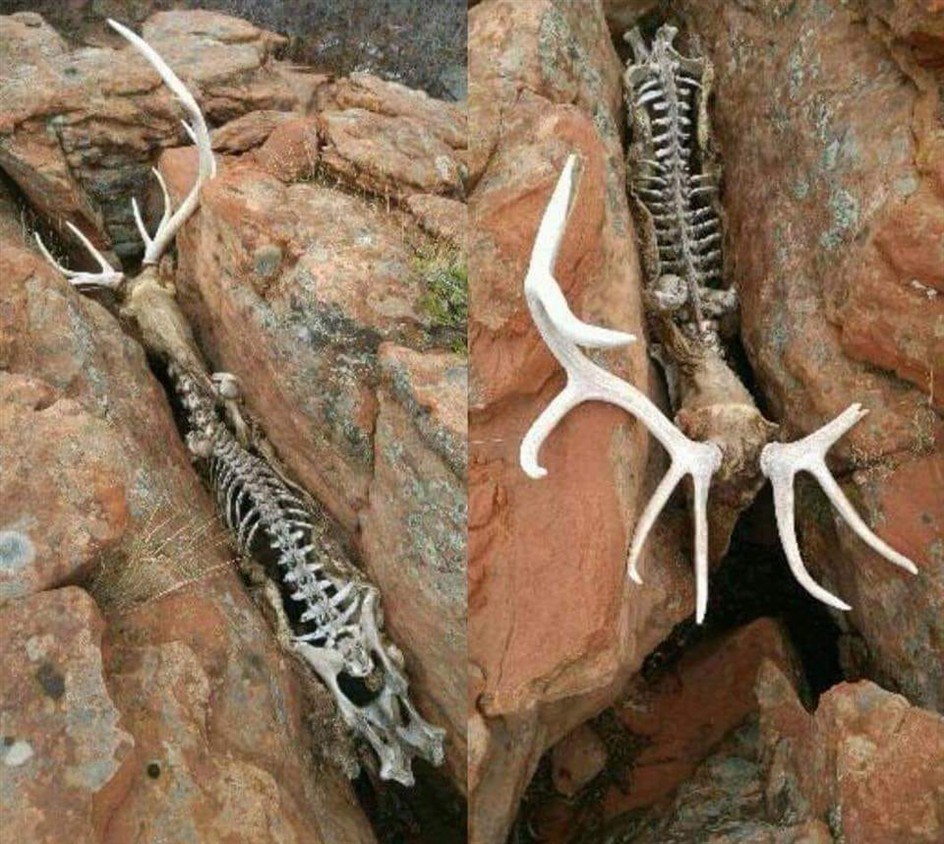Bones in the Stone: A Silent Testament of the Wild

High in the rugged mountains of North America, nature tells its stories not only through living landscapes but also through the stillness of death. In one narrow crevice, skeletal remains of a deer lie locked in eternal repose—a haunting tableau shaped by time, weather, and circumstance. Known simply as Bones in the Stone, this scene stands as both a brutal reminder of mortality and a strangely beautiful testament to the cycles that govern the natural world.
A Creature Trapped in Time

The deer’s final moments likely came decades ago. Perhaps it wandered into the rocky gap in search of safety or food, only to become trapped beyond escape. Over time, its body surrendered to the elements, leaving behind stark white bones pressed against the reddish-brown rock. The contrast of bleached remains against weathered stone creates a powerful visual—life reduced to silence, framed by geology.
This frozen scene highlights nature’s indifference. For the mountains, the death of one creature is not a tragedy but simply another layer in the endless passage of time.
Death Transformed Into Art
What makes this discovery so evocative is the eerie beauty that has emerged. Spiders have claimed the space, weaving gossamer webs across the deer’s antlers. These delicate veils shimmer in the light, transforming skeletal remains into something ghostly and sacred. The tableau captures the paradox of decay: in death, new life thrives.
For hikers and naturalists, such sights inspire reflection. They reveal that the wilderness is not only a place of vitality but also a gallery of endings, where bones, stone, and wind conspire to create art that no human hand could replicate.
The Cycle of Life and Death

Ecologically, the scene is a small but vivid reminder of how life feeds into life. The deer’s body would once have nourished insects, scavengers, and soil alike. Its bones, now fossil-like in appearance, are reminders of the nutrient cycles that sustain ecosystems. Even in stillness, the remains continue to influence the environment—providing shelter for spiders and a perch for moss or lichen.
Nature, in this sense, offers no permanence. Every leap, every fall, every still moment belongs to a cycle that transforms energy endlessly between life and death.
A Meditation on Mortality
Bones in the Stone resonates beyond biology. For many, it evokes questions about fragility, impermanence, and the fleeting nature of existence. Just as the deer once moved through the wild with vitality, it now rests in silence—its story etched into the stone that will outlast it by millennia.
The haunting beauty of the scene lies in its honesty: nature does not shield us from endings. Instead, it offers reminders that life’s brilliance is inseparable from its brevity.
Conclusion
The skeletal deer resting within the mountain crevice is more than a natural curiosity—it is a silent story of struggle, surrender, and transformation. In the interplay of bleached bones, red stone, and silken webs, we glimpse both brutality and beauty, silence and continuity. Bones in the Stone is a testament not only to the wild but also to the universal truth that life, death, and renewal are inseparable threads in the fabric of existence.











